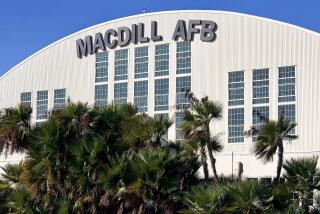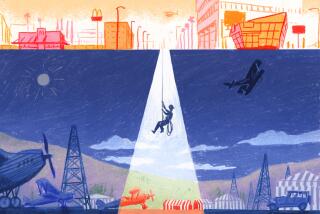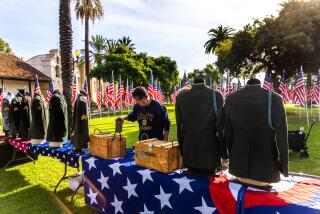Historical Museum Is Readying for Takeoff on a Smaller Scale : History: Edwards Air Force Base attraction has been more than a decade in the making. Finances prevent construction of larger exhibiting space.
- Share via
EDWARDS AIR FORCE BASE — More than a decade after the idea was born, a museum to preserve the rich history at Edwards Air Force Base is finally beginning to take shape.
The museum is a pittance of the ultimate vision, but supporters say at least it’s something.
Nestled on the sprawling military base, in an old government-run shopping center between a recreation equipment check-out center and a liquor store, the museum--without anywhere near enough room to display an airplane--is slated to open in late April.
“It’s something we have to do, to prove our credibility, our viability,” said Doug Nelson, the lone government-paid museum employee. “You can just talk and talk and talk for so long. At some point you’ve got to put up or shut up.”
When Nelson retired from a 22-year career with the Air Force to take the museum job in late 1986, he thought it would be six months before there was a museum.
“I was very naive coming into it,” he said. “I really thought it was going to be a lot quicker.”
Over the years there has actually been more than talk. Besides working on the arduous task of putting together a collection, seven planes have been restored and put on static display at the Jimmy Doolittle Airpark at Edwards. An equal number are set atop pedestals at various places on the base. And in late 1991, a museum annex known as Blackbird Airpark--which features a display of the famous reconnaissance plane, the SR-71 and its predecessor, the A-12--was opened at Plant 42 in Palmdale.
But Edwards, which was first used by the military in 1933 as a bombing and gunnery range, remains without a museum, despite being counted among the 23 Air Force base museums in the country. On the 335 acres the Air Force set aside years ago for the museum, there is nothing more than the sparse Jimmy Doolittle Airpark with its small aircraft display.
Finally--years later than anyone expected--a so-called starter museum is close to reality.
The museum is being constructed in a 2,400-square-foot space that most recently housed a dime store. Nelson and volunteers are doing the work. About 1,200 square feet of exhibit space will include historical displays, a gift shop, a video viewing room, reference library and a wall with models of each of the 100 or so airplanes that made their first flights at Edwards.
It is a far cry from the 60,000-square-foot museum complex that a Bakersfield architectural firm designed several years ago. But it is about all that is financially realistic. A private, nonprofit foundation raising money for construction costs is little more than a third of the way to its $6-million goal.
Although tax dollars are used to operate military museums, government funds may not be used to construct them, said Geoffrey Hays, program coordination division chief for the U.S. Air Force Museum at Wright-Patterson Air Force Base in Dayton, Ohio.
Eleven years ago, a group of people concerned about preserving and sharing the vast history of Edwards formed the Flight Test Historical Foundation to raise money to build a museum at the base.
Because “the heritage of flight research and flight testing accomplished at Edwards Air Force Base was being lost, a group of concerned citizens--retired aerospace executives and test pilots, research and development specialists, aviation historians, representatives of the business community, and national and local civic leaders--banded together to form the Flight Test Historical Foundation,” according to an information statement from the foundation.
A 1985 moratorium by the Secretary of the Air Force prohibiting new museums could have put a stop to the foundation’s plans before they took flight. But with much effort, an exception to the moratorium was granted--the only exception to the moratorium that remains in effect.
The exception was granted, Hays said, because of the foundation’s support and the desire of the leadership at Edwards to have a museum. “The history of Edwards is incredible,” he said, “it’s just absolutely incredible.”
Among those 100 or more first flights that occurred at Edwards is that of an American jet, the Bell XP-59A, in 1942. A Bell X-1 piloted by Charles E. (Chuck) Yeager in 1947 was the first to travel faster than the speed of sound.
First flights are by no means all that makes Edwards renowned in the world of aviation. Assemblyman William J. (Pete) Knight (R-Palmdale) was at the controls of an X-15 in 1967 when it set a world speed record of 4,520 m.p.h. The first landing of a space shuttle, the Columbia, occurred at the base in 1981.
Aircraft and orbiters are not all that is important to the history of Edwards. The more than 2,000 artifacts that have been amassed by the museum include only 63 aircraft.
Those aircraft include the first F-111 fighter jet, the only two experimental X-21s that were made, and the only one of the three original NF-104s still in existence. The NF-104 is a rocket-assisted aircraft.
“One of my primary tasks was to assemble a significant collection of historical aircraft,” Nelson said. “I spent a lot of my time finding out where aircraft that flew at Edwards are. We’ve acquired airplanes from all over the country.”
Of course, the history of the Mojave Desert land that is now known as the Air Force Flight Test Center predates the military’s presence.
Nelson, who formally holds the dual title of museum director/curator, hopes to convey all of the base’s history in the museum, although there will be little room for that in 1,200 square feet.
More to Read
The biggest entertainment stories
Get our big stories about Hollywood, film, television, music, arts, culture and more right in your inbox as soon as they publish.
You may occasionally receive promotional content from the Los Angeles Times.










